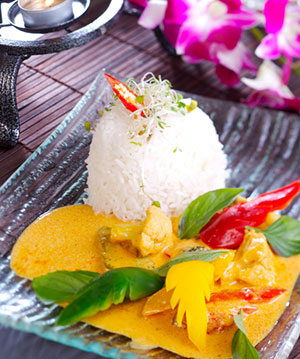
Why go to a Thai restaurant?
Here are just a few of the Thai recipes we have for you in our online store. What’s more you can purchase most of the ingredients for each recipe at the click of a button, instead of having to hunt them down individually.
Thai starters and Thai soups Thai salads Thai main coursesThe secret to successful Thai cooking lies in the preparation of ingredients ahead of time, especially when using a wok, since the actual cooking is fast and furious. Most Thai stir-fries (including noodle dishes) are cooked at high heats and for only a few minutes, which is what makes them particularly fresh and delicious. Another advantage of this method is that most of the nutrients remain in the food—vegetables, especially, maintain their vitamin content as well as their satisfying crunchiness.
When preparing Thai dishes, start with anything that sounds like a "paste" or spices that require grinding. This can be done the old-fashioned way with a pestle & mortar, or you can use a food processor (or a coffee grinder, if the ingredient to be ground is a dry spice, such as coriander seeds).
Next, chop all vegetables and place them aside on the counter, keeping them separate according to their cooking order. Lastly, chop up the meat (if using) or meat substitute (tofu or wheat gluten).
Thai cooking requires a minimum of cooking tools and utensils. The wok is the primary cooking tool (a deep frying pan is a good substitute), used with wooden spoons or “shovels” (spatulas) to stir-fry ingredients. When purchasing a wok, look for high-quality stainless steel. If you prefer a non-stick coating, be sure only to use soft spatulas during cooking, as anything harder will scrape the surface off and into your food.
In Thailand, chefs commonly use coconut or peanut oils for stir-frying and deep-frying. Try these (I recommend buying organic oils for the highest nutritional benefits), or other heat-tolerant oils such as canola, sunflower or safflower, corn, and almond oil (or other nut oils).
Before beginning to stir-fry, make sure your oil and all other ingredients—including sauces—are close by, as there won’t be time to look for anything once you start. For most stir-fries (including noodles), keep the heat on high to medium-high, as this ensures a good result. If the oil in your wok splatters, the heat may be too high, although usually this effect goes away as you continue to add more ingredients or more moisture to the wok.
Lastly, have your serving platter clean and ready to go, and make sure those lucky people who’ll be enjoying your Thai meal are also nearby! Thai food is best when eaten fresh from the wok.



